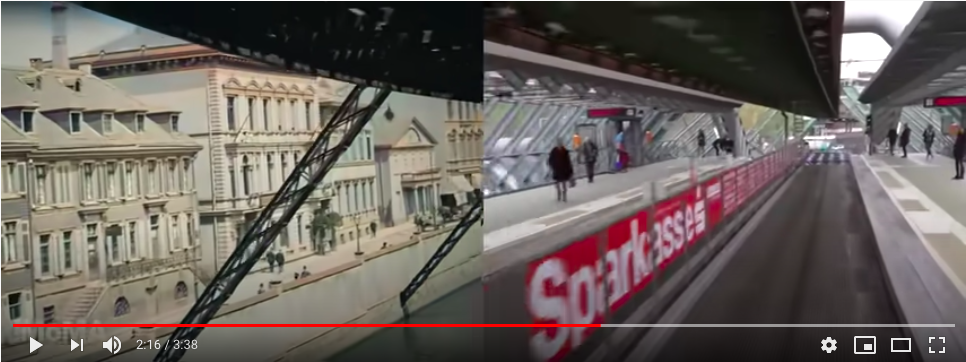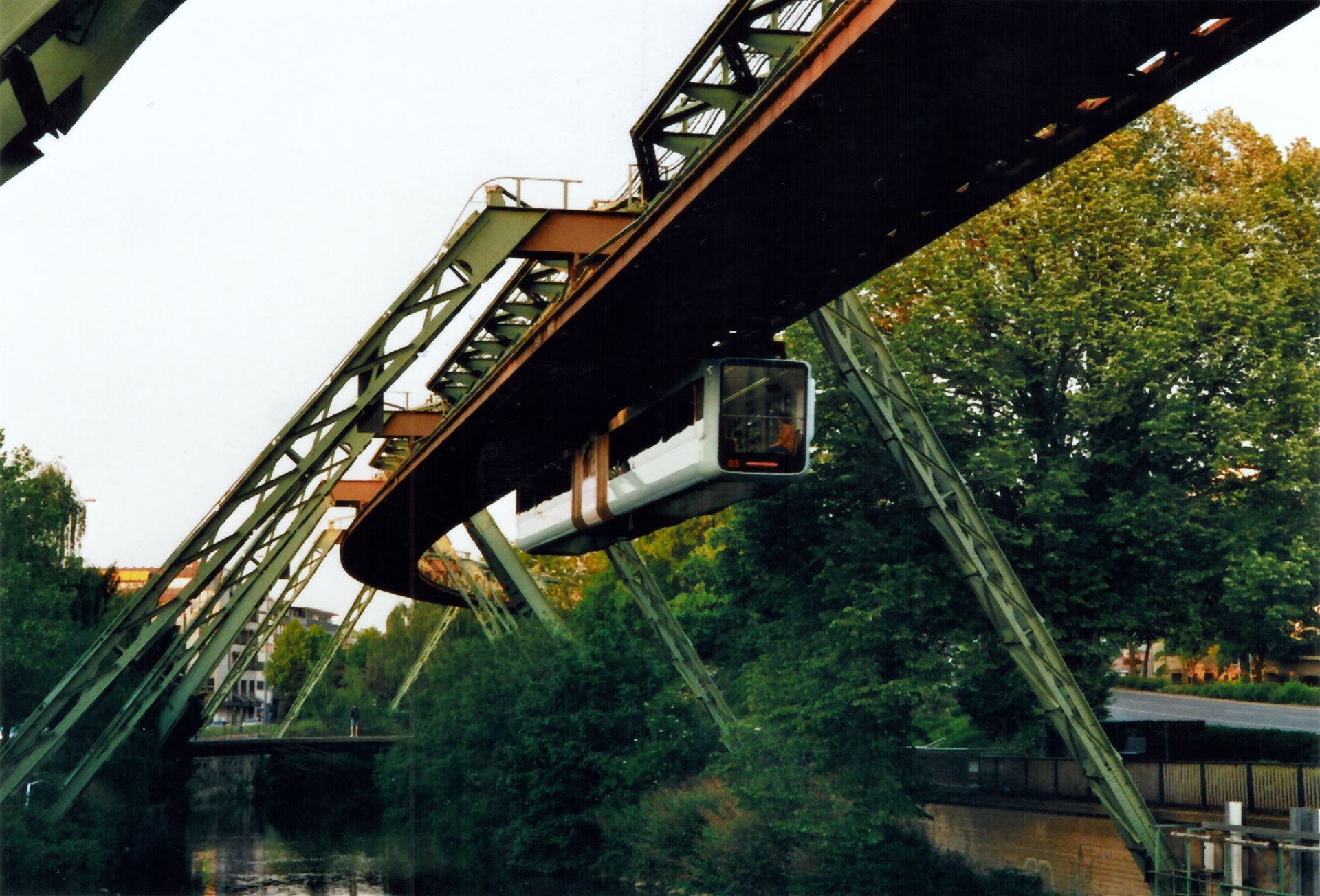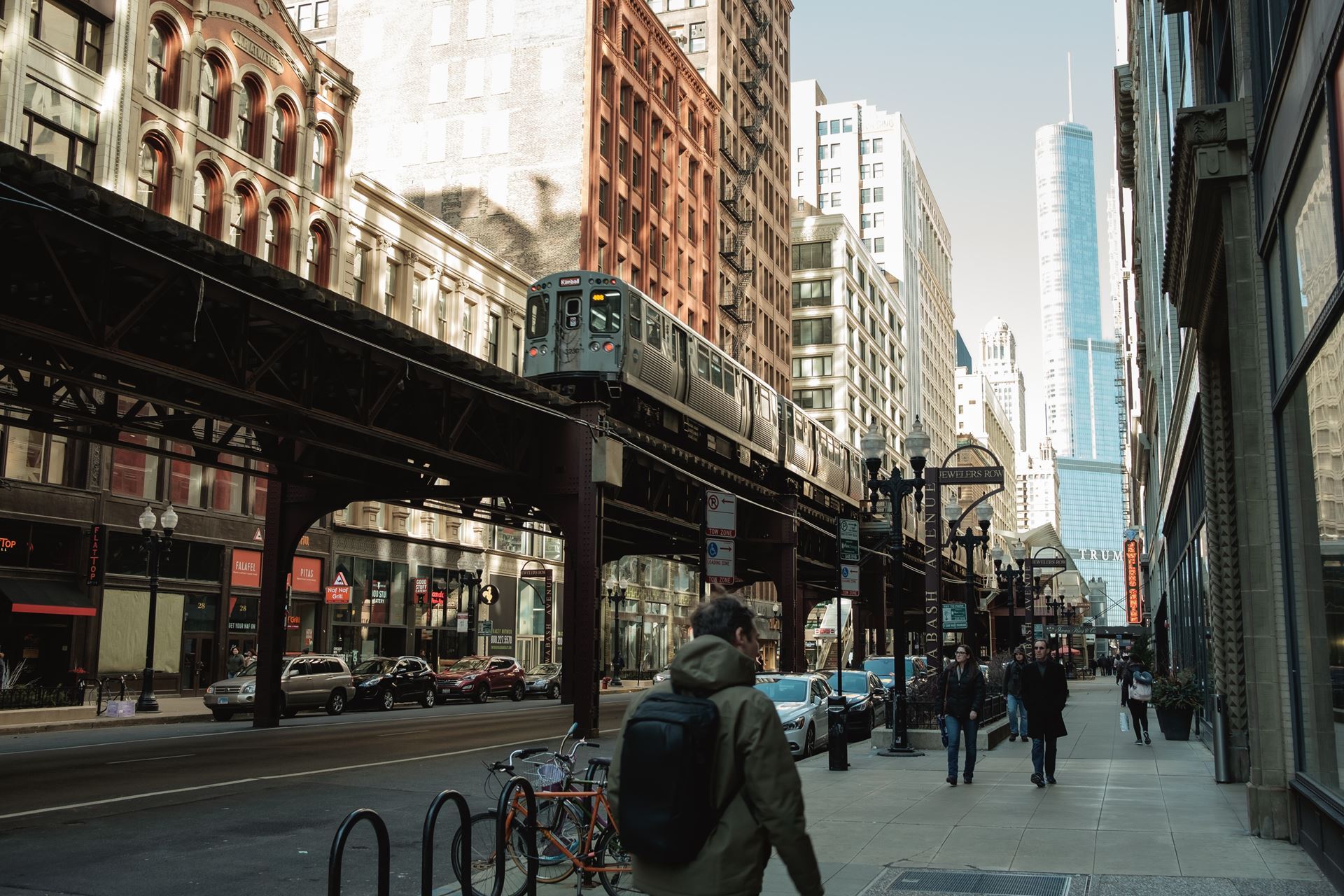Written by Rolf Achilles, an art and architecture historian with a special interest in Chicago and its community of artists/craftsmen. Rolf was the founding curator of the Smith Museum of Stained Glass Windows at Navy Pier and the curator of the current installation of windows in the Macy’s Pedway.
On August 9, 2020, the Museum of Modern Art released on YouTube Video, "The Flying Train (1902) | MoMA FILM VAULT SUMMER CAMP." It's a lightly colorized restoration of a 1902 film showing the extraordinary, "flying" view from Europe's most peculiar urban metro, the Wuppertal Suspended Railway (the Schwebebahn) wending its way above streets and the River Wupper. For a 1902 and 2015 side by side ride, see: "Wuppertal Schwebebahn 1902 & 2015 side by side video," also on YouTube.

The city of Wuppertal, Nord Rhein-Westfalen, Germany, in North Rhine-Westphalia, lies about 20 km east of Düsseldorf and has about 355,000 inhabitants. In 1929 when Elberfeld, Barmen, Vohwinkel, and several other smaller municipalities joined to form a new city, Wuppertal, named after the Wupper River valley.
Decades before Elberfeld, Barmen, and Vohwinkel became Wuppertal; the three municipalities had accepted the Einschienige Hängebahn System Eugen Langen (the one-track hanging train system of Eugen Langen), a system that had previously been rejected by Berlin, Breslau, and Munich. Acceptance of the Langen system was in 1894, construction began in 1897, and the first track opened March 1, 1901, between Kluse and Zoo. The western section, between Zoo and Vohwinkel, followed on May 24. Eugen Langen (1833-1895) was an entrepreneur, engineer, and inventor from Köln (Cologne), Germany.
Its immediate popularity credits the Schwebebahn with the growth of the original cities that merged to found Wuppertal. During World War II, the line was seriously damaged, with service restored within a year after the war. It continues in operation today.
 The Schwebebahn in Wuppertal. Photo by RoestfrischerKaffee on Unsplash.
The Schwebebahn in Wuppertal. Photo by RoestfrischerKaffee on Unsplash.
In 1901, the Eugen Langen system was also sold to Dresden, Germany, where the Dresden Suspension Railway (Schwebebahn Dresden), a suspended funicular system, is still in service between the districts of Loschwitz and Oberloschwitz. Supported by 33 pillars, the line is 274 meters (899 ft) long. The Wuppertal line is 13.3 km (8.3 miles) long, has 20 stations, and transports 82,000 people per day.
The Wuppertal Schwebebahn is the world's oldest electric suspension railway, but not the first over the street electric urban railway. That distinction belongs to the Chicago "L," the elevated train that first ran on June 6, 1892, from 39th street (now Pershing Road) and State Street to Congress Parkway and Wabash Avenue.
 The Chicago "L" train in the Loop. Photo by Johannes Krupinski on Unsplash.
The Chicago "L" train in the Loop. Photo by Johannes Krupinski on Unsplash.
By 1893, the Chicago and South Side Rapid Transit Railroad extended this line to Jackson Park and the World's Columbian Exposition of 1893.
A week after the Fair closed on October 30, 1893, a second, elevated line began running on November 6, as the Lake Street Elevated Railroad. In 1895 the Metropolitan West Side Elevated followed with lines to Douglas Park, Garfield Park, Humboldt Park, and Logan Square. It was the nation's first non-exhibition rapid transit system powered by electric traction motors.
During the second half of the 19th century, many cities in Europe and the US had horse-drawn streetcars, known as horsecars. They were contributors to the newly invented urban traffic congestion generated by rapidly expanding cities. No city in the world added population faster than Chicago! In 1900 there were perhaps 100,000 horses and 1.7 million people in Chicago. Its congestion and pollution became legendary. A solution was a privately funded, city-approved steel rib-like structures spanning certain city center streets that also radiated south, north, and west through neighborhoods much as the horsecars did only not on the congested streets. The first steam locomotives quickly gave way to "electric traction." Electric traction trains were the future that fit neatly into Chicago's already much electrified Loop with light bulbs and elevators.
But Chicago's "L" was not the world's first electric tram line. That credit goes not to a private but city-funded street-level system built by Werner von Siemens in Licterfelde near Berlin, Germany, in 1881. A year earlier, Siemens had proposed an electric subway for Berlin. Almost two decades later, an overhead railway, running along a viaduct, opened in 1896, followed in 1897, by establishing a company to build both an electric overhead and underground railways. The underground quickly dominated Berlin and became the U-Bahn (Untergrundbahn).
 The U-Bahn (subway) stop Bundestag (capitol building). Photo by Victor Kallenbach on Unsplash.
The U-Bahn (subway) stop Bundestag (capitol building). Photo by Victor Kallenbach on Unsplash.
By the way, the earliest elevated railway was the London and Greenwich Railway, London, England, run on a Roman-style brick viaduct of 878 arches, built between 1836 and 1838.
From the late 1860s on, elevated railways run on viaducts became popular in US cities.
Besides steam and electric powered trains, there were also cable cars on municipal streets. Andrew Smith Hallidie officially invented these in San Francisco in 1873. Of the eventual 23 lines, three continue to operate in San Francisco today. In New York, the West Side and Yonkers Patented Railway served with cable cars from 1868 to 1870; thereafter, locomotives pulled them.
With the opening in 1882 of cable lines to the south on State Street and Wabash-Cottage Grove Avenue, Chicago entered the cable car system into its urban street congestion. It was immediately successful. In 1886 a cable line on Clark Street and parallel 5th (now Wells Street) went into service. In 1889 a branch on Lincoln Avenue opened, followed by Clybourn Avenue in 1891. By 1887 the State Street lines extended to 63rd Street and Cottage Grove Avenue extended to 71st Street in 1890. Cable cars ran in Chicago from 1882-1906. s
Underground trains like the London Tube and the Paris Metro or Berlin's U-Bahn, are another story.
